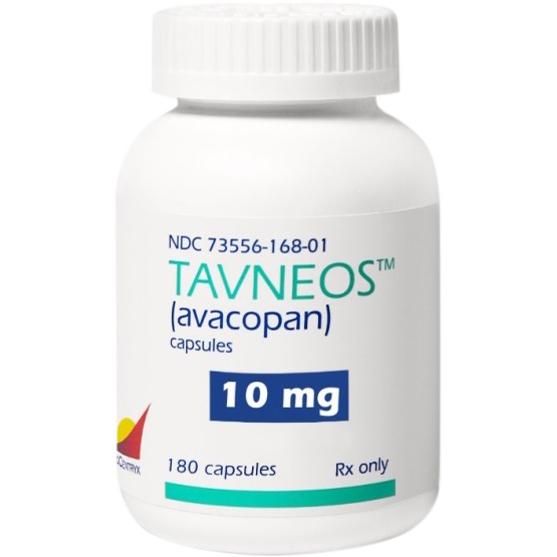Generic Tavneos Availability
Last updated on Aug 6, 2025.
Tavneos is a brand name of avacopan, approved by the FDA in the following formulation(s):
TAVNEOS (avacopan - capsule;oral)
-
Manufacturer: CHEMOCENTRYX
Approval date: October 7, 2021
Strength(s): 10MG [RLD]
Is there a generic version of Tavneos available?
No. There is currently no therapeutically equivalent version of Tavneos available in the United States.
Note: Fraudulent online pharmacies may attempt to sell an illegal generic version of Tavneos. These medications may be counterfeit and potentially unsafe. If you purchase medications online, be sure you are buying from a reputable and valid online pharmacy. Ask your health care provider for advice if you are unsure about the online purchase of any medication.
See also: Generic Drug FAQ.
Related patents
Patents are granted by the U.S. Patent and Trademark Office at any time during a drug's development and may include a wide range of claims.
-
Amorphous form of a complement component C5a receptor
Patent 11,603,356
Issued: March 14, 2023
Inventor(s): Yau; Kwok et al.
Assignee(s): CHEMOCENTRYX, INC. (San Carlos, CA)Provided herein is an amorphous form of a complement component 5a receptor having the formula of Compound 1 ##STR00001## Also provided herein are pharmaceutical compositions and methods of treatment using the amorphous form of Compound 1, described herein.
Patent expiration dates:
- May 29, 2041✓✓✓
- May 29, 2041
-
Capsule formulations
Patent 11,951,214
Issued: April 9, 2024
Inventor(s): Leleti; Manmohan Reddy et al.
Assignee(s): CHEMOCENTRYX, INC. (Thousand Oaks, CA)The present disclosure provides solid solution capsule formulations of Compound 1 ##STR00001##
and methods of making the same. Also provided herein are methods of treating individuals suffering from or susceptible to a disease or disorder involving pathologic activation of C5a receptors by administering an effective amount of one or more solid solution capsules comprising Compound 1. Further provided herein are singe unit dosage capsules comprising certain amounts of Compound 1, and kits comprising a solid solution capsule comprising Compound 1.Patent expiration dates:
- November 27, 2039✓
- November 27, 2039
-
C5aR antagonists
Patent 8,445,515
Issued: May 21, 2013
Inventor(s): Fan Pingchen & Greenman Kevin Lloyd & Leleti Manmohan Reddy & Li Yandong & Powers Jay & Tanaka Hiroko & Yang Ju & Zeng Yibin
Assignee(s): Chemocentryx, Inc.Compounds are provided that are modulators of the C5a receptor. The compounds are substituted piperidines and are useful in pharmaceutical compositions, methods for the treatment of diseases and disorders involving the pathologic activation of C5a receptors.
Patent expiration dates:
- February 3, 2031✓✓
- February 3, 2031
-
C5aR antagonists
Patent 8,906,938
Issued: December 9, 2014
Inventor(s): Fan Pingchen & Greenman Kevin Lloyd & Leleti Manmohan Reddy & Li Yandong & Powers Jay P. & Tanaka Hiroko & Yang Ju & Zeng Yibin
Assignee(s): ChemoCentryx, Inc.Compounds are provided that are modulators of the C5a receptor. The compounds are substituted piperidines and are useful in pharmaceutical compositions, methods for the treatment of diseases and disorders involving the pathologic activation of C5a receptors.
Patent expiration dates:
- December 21, 2029✓✓
- December 21, 2029
Related exclusivities
Exclusivity is exclusive marketing rights granted by the FDA upon approval of a drug and can run concurrently with a patent or not. Exclusivity is a statutory provision and is granted to an NDA applicant if statutory requirements are met.
Exclusivity expiration dates:
- October 7, 2026 - NEW CHEMICAL ENTITY
- October 7, 2028 - AS AN ADJUNCTIVE TREATMENT OF ADULT PATIENTS WITH SEVERE ACTIVE ANTI-NEUTROPHIL CYTOPLASMIC AUTOANTIBODY (ANCA)-ASSOCIATED VASCULITIS (GRANULOMATOSIS WITH POLYANGIITIS [GPA] AND MICROSCOPIC POLYANGIITIS [MPA])
More about Tavneos (avacopan)
- Check interactions
- Compare alternatives
- Pricing & coupons
- Reviews (4)
- Drug images
- Side effects
- Dosage information
- During pregnancy
- FDA approval history
- Drug class: selective immunosuppressants
- Breastfeeding
- En español
Patient resources
Professional resources
Related treatment guides
Related/similar drugs
Glossary
| Term | Definition |
|---|---|
| Drug Patent | A drug patent is assigned by the U.S. Patent and Trademark Office and assigns exclusive legal right to the patent holder to protect the proprietary chemical formulation. The patent assigns exclusive legal right to the inventor or patent holder, and may include entities such as the drug brand name, trademark, product dosage form, ingredient formulation, or manufacturing process A patent usually expires 20 years from the date of filing, but can be variable based on many factors, including development of new formulations of the original chemical, and patent infringement litigation. |
| Drug Exclusivity | Exclusivity is the sole marketing rights granted by the FDA to a manufacturer upon the approval of a drug and may run simultaneously with a patent. Exclusivity periods can run from 180 days to seven years depending upon the circumstance of the exclusivity grant. |
| RLD | A Reference Listed Drug (RLD) is an approved drug product to which new generic versions are compared to show that they are bioequivalent. A drug company seeking approval to market a generic equivalent must refer to the Reference Listed Drug in its Abbreviated New Drug Application (ANDA). By designating a single reference listed drug as the standard to which all generic versions must be shown to be bioequivalent, FDA hopes to avoid possible significant variations among generic drugs and their brand name counterpart. |
Further information
Always consult your healthcare provider to ensure the information displayed on this page applies to your personal circumstances.

